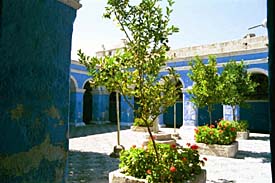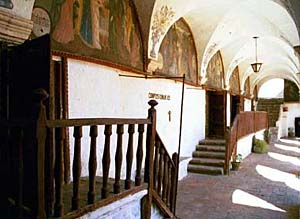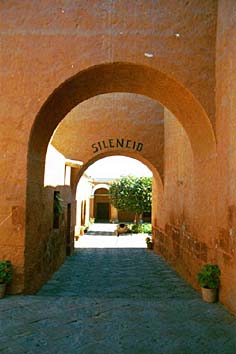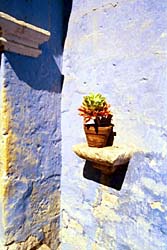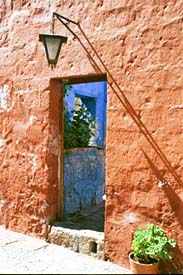 Arequipa's
Santa Catalina Monastery is spectacular-- architecturally the most
important and prestigious religious building anywhere in Peru.
As the Lonely Planet Peru guidebook says, it certainly wins the
"most fascinating colonial religious building in Peru"
award. It's enormous--over 20,000 square meters and covering an
entire city block--so our visit here, wandering through the complex of
rooms, cloisters and tiny plazas, took a good two hours. The most
striking general feature of the monastery's architecture is its
predominately Mudejar style, adapted by the Spanish from the Moors,
but rarely found in their colonial buildings. The quality of the
design is emphasized and beautifully harmonized by an incredible
interplay between the strong sunlight, with stone and brilliant
colors--on the ceilings and in the deep blue sky above the maze of
narrow interior streets. Arequipa's
Santa Catalina Monastery is spectacular-- architecturally the most
important and prestigious religious building anywhere in Peru.
As the Lonely Planet Peru guidebook says, it certainly wins the
"most fascinating colonial religious building in Peru"
award. It's enormous--over 20,000 square meters and covering an
entire city block--so our visit here, wandering through the complex of
rooms, cloisters and tiny plazas, took a good two hours. The most
striking general feature of the monastery's architecture is its
predominately Mudejar style, adapted by the Spanish from the Moors,
but rarely found in their colonial buildings. The quality of the
design is emphasized and beautifully harmonized by an incredible
interplay between the strong sunlight, with stone and brilliant
colors--on the ceilings and in the deep blue sky above the maze of
narrow interior streets.
Today, the approximately 20 remaining nuns continue to live a cloistered life, but only in the northern corner of the complex. As I walked down the maze of narrow interior streets, I tried to imagine what life might be like for the closeted nuns--open to the skies and the city sounds, yet bounded by the monastery's high walls. The monastery actually has a very interesting, at times unexpected, history. Here is a bit of the history as explained by Lonely Planet: "The Monasterio de Santa Catalina was built in 1580 and was enlarged in the 17th century. The founder was a rich widow, Maria de Guzman, who only accepted nuns from the best Spanish families. All the nuns had to pay a dowry. Traditionally, the second daughter of upper-class families entered a nunnery, supposedly to live in poverty and renounce the material world. In fact, each nun at Santa Catalina had between one and four servants or slaves, and the nuns were able to invite musicians to perform in the convent, have parties and generally live the style to which they had become accustomed while growing up. After about three centuries of these goings-on, the pope complained that Santa Catalina was more like an exclusive social club than a convent, and he sent Sister Josefa Cadena, a strict Dominican nun, to straighten things out. She arived in 1871, sent all the rich dowries back to Europe, and freed all the servants and slaves, giving them the choice to stay on as nuns or leaving. The convent
has always been surrounded by imposing high walls, and the
approximately 450 people (about a third of them nuns and the rest
servants) who once lived here never ventured outside the
convent. Accordingly, the place was shrouded in mystery for
almost 400 years. It finally opened to the public in 1970 when
the mayor of Arequipa forced the convent to comply with laws,
requiring it to install electricity and running water. The nuns,
now too poor to do this, opened their doors to tourism to pay for the
modernization." (Lonely Planet Peru) |
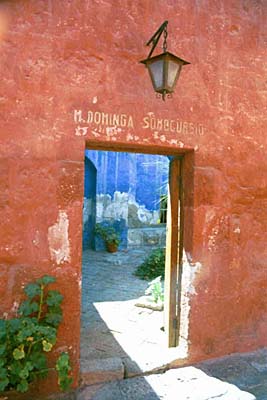 |
|
|
|
|
|
|
 |
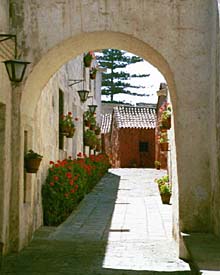 |
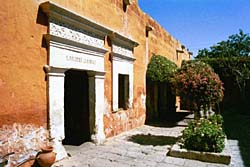 |
|
|
 |
 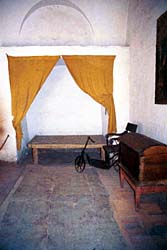 |


